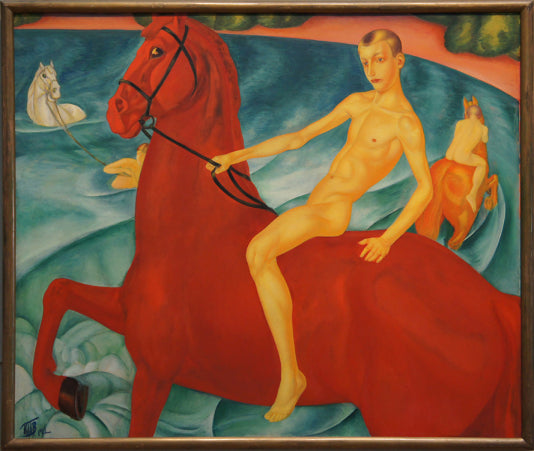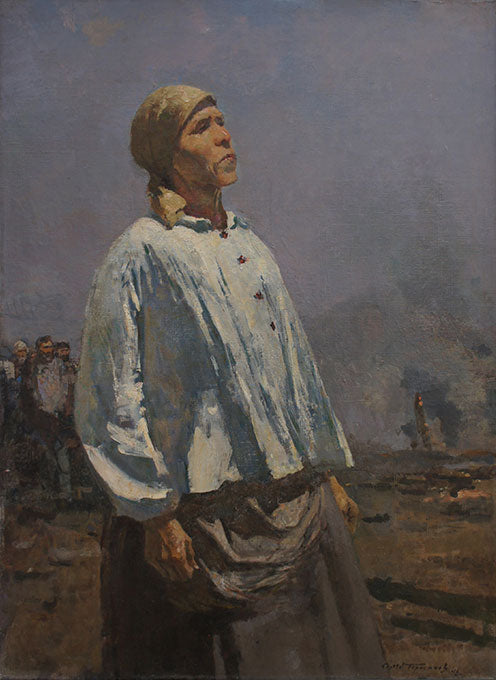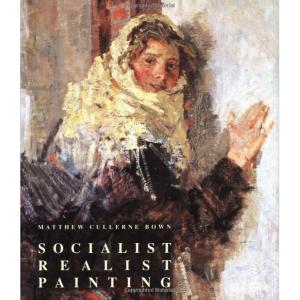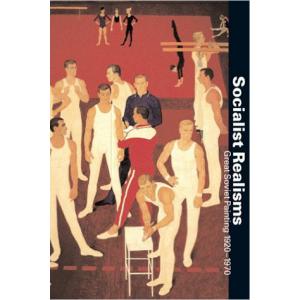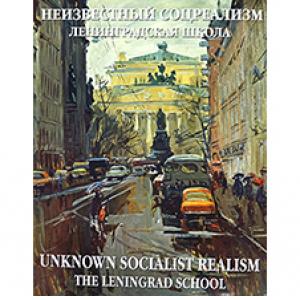The Early Years of Soviet Realism
by Cathy Locke

Kuzma Petrov-Vodkin, “Bathing the Red Horse,” 1912, oil on canvas
The artistic style known as Soviet Realism was conceptualized by Joseph Stalin (1878-1953) to brand his administration’s propaganda. As early as 1921 the Soviet government had begun to shift their preferences away from the avant-garde Vladimir Lenin (1870-1924) had favored to a more traditional approach. During the 1920s artists of the Russian avant-garde began feeling more and more pressure from the Soviet ideologues forcing them to completely change their artistic style. With the death of Lenin, and Stalin’s emergence to power, art schools teaching theories of the Russian avant-garde were quickly dissolved. Stalin wanted to distance himself from Lenin’s brand and was looking for something that went in a completely different direction. Stalin began by making claims that Kazimir Malevich’s (1879-1935) suprematist work was “bourgeois” art and that the only art that could be publicly exhibited had to have “educational value.” The large collection of impressionist and post-impressionist paintings in Russia were taken off their stretcher bars, rolled, then packed into trains and shipped off to Siberia, all because they contained no educational value. Fine artists began searching for subject matter to represent the demands of Soviet censorship. Drawing on Russia’s history of icon art, Kuzma Petrov-Vodkin (1878-1939) was one of the first Russian artists to win fame for his painting, Bathing the Horse in the 1920s. This genre painting of boys bathing their country horses in a river became a revolutionary icon during the early Soviet years. The red color typically associated with Russia took on a new political meaning representing the new Soviet transformation. Soviet ideologues saw the painting as a call for spiritual cleansing. Each generation of viewers since has projected their own historical traumas – along with their expectations and hopes – on the picture.1 The composition is made up of contrasting large and small figures. The central red horse is moving counter-clockwise disturbing the circular flow of the figures in the background. The red horse is literally larger than life, representing a change in direction that cannot be ignored. It is believed that Petrov-Vodkin was influenced by the painting, Music and Dance by Henri Matisse (1869-1954), which had come to Moscow one year prior to the creation of Bathing the Horse. There are many ways to interpret this painting, but one might be that the large red horse depicts Stalin marching in his own direction while stirring the pond that Lenin had created.

Kazimir Malevich, “Girls in a Field,” 1928-1929, oil on canvas
Steps to return to a traditional artistic style officially began with the adoption of Stalin’s decree in April 1932 that dissolved all existing literature and arts organizations to form one unified creative union that dictated all creative output, including education. On August 2, 1932 the Leningrad Union of Soviet Artists was born and ushered in the era of Soviet Realism. By 1934 the Russian congress had established guidelines for Soviet Realist art2, which was as follows:
- Proletarian: art relevant to the workers and understandable to them.
- Typical: scenes of everyday life of the people.
- Realistic: in the representational sense.
- Partisan: supportive of the aims of the State and the Party.

Kazimir Malevich, “Head of a Peasant,” 1928-1929, oil on canvas
Not all artists lined up to follow Stalin’s censorship. Of course our favorite tragic hero, Kazimir Malevich, resisted. In his painting, Girls in a Field (1928), Malevich is making a statement on political oppression by depicting the figures in uniforms with no individuality. In his painting, Head of a Peasant (1928), we see a face with no mouth. Malevich is saying, “Don’t speak, and don’t tell the truth.” Stalin had his paintings confiscated and he was banned from creating and exhibiting such work. Malevich responded by saying “art can advance and develop for art’s sake alone. Art does not need us, and it never did.” On September 20, 1930 Malevich was arrested and taken to prison. When he was released six months later, he began to apply his talents to costume design.
Soviet Realism, also referred to as sotsrealism and Stalin’s neoclassicism set out to create a brand new proletarian culture. Stalin’s philosophy was that treasures previously only available to the elite would now be offered to the working class. In fact farm and factory workers were given an opportunity to spend a few weeks in a palace once a year.3 During the age of sotsrealism many buildings were turned into palaces. A massive subway system was built and designed to be the “People’s Palaces.” The phenomenon of Stalin’s neoclassicism defined not only art, but government and state planning. It became the job of the commissioner of education, Anatoly Lunacharsky (1875-1933), to envision Russia’s new artistic brand and to enforce the government’s first censorship system. Artists of all types carried the burden of this censorship. Ironically Lunacharsky, who had founded an avant-garde organization known as Proletkult during the Lenin years, now had to distance himself from such art. So all Russian artists began searching for ways to work within the guidelines of Soviet Realism. With a definite shift toward figurative work fine artists began creating dramatized images of factory workers, new leaders, heroes and martyrs of the revolution. As well, meetings with state leaders, celebrations, sports and labor achievements all became new subjects for Russian artists. Even still life and landscape genres took on a new type of abundance on a grand scale.

Isaak Brodsky, “Lenin in the Smolny,” 1930, oil on canvas
An Early Success
The painting, Lenin in Smolny by Isaak Brodsky (1883-1939), became an iconic artwork symbolizing the early years of Soviet Realism. The painting was done after Lenin’s death and was intended to canonize the image of the leader of the world proletariat. Copies of this painting were reproduced in the millions and hung in all the great Soviet institutions. Lenin disliked posing for paintings and had to be convinced by Lunacharsky that Brodsky was one of the most talented artists of their time. In fact, Brodsky had been the star pupil of one of Russia’s greatest painters, Ilya Repin (1844-1930). Since 1917 Brodsky had dedicated himself to painting revolutionary art and had created an entire series on Lenin prior to painting Lenin in Smolny. Though painted in 1930, Lenin in Smolny, “takes us back to the first few months of the Soviet regime, when, from mid-November 1917 until March 10, 1918, the Council of People’s Commissars and Lenin’s office were situated inside the Smolny Institute*.”4 In stark contrast to the opulence of the previous tsarist regime, Brodsky depicts a modest environment that works to amplify the silence in the room. The figure is drawn almost life size, which enhances the feeling that the viewer is right before the leader. Lenin is lost in his work and wrapped in shadow that literally blends him into the room. This is not a typical portrait from the 1800s, but a statement filled with emotional feeling. The myth surrounding this leader was his great capacity for work; therefore this portrait doesn’t illustrate his physical form but his contribution to Soviet policies. Lenin is surrounded by darkness that is contrasted by the humble white cloths draped over the two armchairs. The vacant armchair symbolizes the emptiness of the room emphasizing a deep feeling of loneliness. The artist paints every detail right up to the electricity cabling and outlet. Two years after he painted Lenin in Smolny, Brodsky became the director of the Institute of Painting, Sculpture and Architecture and was awarded a large apartment on Arts Square in St. Petersburg.

Alexander Deineka, "Textile Workers," 1927, oil on canvas

Alexander Samokhvalov, "Conductress," 1928, tempera on canvas
Artistic Transformation
Many of the post-revolutionary wave of artists initially attempted to retain some form of freedom in their work. An artistic style called Soviet Modernism emerged during the avant-garde years before Soviet Realism. Stalin was creating a centrally planned command economy and as a result the country underwent a period of rapid industrialization. Artists of Soviet Modernism were influenced by this industrialization and began working with this theme. Textile Workers (1927) by Alexander Deineka (1899-1969) and Conductress (1928) by Alexander Samokhvalov (1897-1971) are two examples of paintings that thematically corresponded to the spirit of Stalin’s new age, yet stylistically are known as Soviet Modernism because they align more closely with the avant-garde. Soviet Modernist artists shared the desire to create a new representative aesthetic in traditional forms of painting; but to Soviet authorities their style had not developed far enough. Artists were supposed to extol the achievements of Socialism and the wisdom of the Party leadership, teaching citizens to love the motherland and do all they could for its well-being.

Alexander Deineka, "Goalkeeper," 1934, oil on canvas
The Unifying Themes
The subject of sports became popular in the 1930s due to the fact that Russia was preparing for war and the citizens needed to unite for a common cause. Both Deineka and Samokhvalov turned to the subject of sports for their paintings. In Goalkeeper (1934) Deineka defies gravity and gives the viewer the feeling of endless space. “Deineka presents a charged moment, a few seconds that could be recorded only with a camera… Rushing for the ball, the goalkeeper seems to hang between earth and sky, and to his viewers’ eyes, his fall is turned into a slow flight…”5 Deineka flattens shapes and exaggerates size in his paintings of the 1930s to create monumental art. In doing so Deineka transforms the sports scene into a world where giants live and are honored as heroes.

Alexander Samokhvalov, "Girl with Shot Put," 1933, oil on canvas
Samokhvalov also worked with the subject of sports, but focused on women. During the period of Soviet Realism women are depicted as male forms entirely devoid of eroticism. Artists had to create a new image of the emancipated woman, equal to a man. In Samokhvalov’s Girl with Shot Put we see a strong young girl filled with energy. Bathed in sunlight she becomes an emissary, a bright “cosmic” light for the future. “In the art of the 1930s, Girl with Shot Put was a rare attempt, in Socialist Realist art, to combine the ancient and Renaissance ideal of corporeality with ideas of symbolic generalization. This was the kind of Socialist Realism of which Anatoly Lunacharsky had dreamt. Lunacharsky saw Soviet art as a mixture of ‘strong, convincing realism’ and ‘transparent symbolism in its decorative and monumental forms.’”6

Alexander Samokhvalov, “Militarized Komsomol,” 1932-33, oil and tempera on canvas
Another subject that Samokhvalov infused women into was the preparation for war against Germany. In his very stylized painting, Militarized Komsomol, we see women learning the skills necessary to be soldiers. “I always saw physical culture as happiness at existing, the happiness that creates the potential to overcome obstacles in the struggle for the construction of a new life,” the artist wrote.7 A master of traditional forms of painting Samokhvalov was able to create a dynamic monumental quality in his work. In Militarized Komsomol he takes the serious activity of learning to fight and creates a scene of vivacious poetry of everyday life.

Joseph Chaiko, “Football Players”, 1928-38, Bronze
As the style of Soviet Realism began to take shape there was quite a large number of excellent sculptures produced. One of the earliest and most successful pieces was Football Players (1928-38) by sculptor Joseph Chaikov (1888-1979), who enjoyed international fame for his work during his lifetime. Chaikov was a descendant from a family of Jews from Kiev. His religion restricted him from being allowed to study in Russia, so he went to Paris and studied at the studio of the sculptor Naum Aronson (1872-1943). After his studies he became part of an international group of Jewish artists that included Marc Chagall (1887-1985), Nathan Altman (1889-1970) and David Shterenberg (1881-1948). Football Players was a government commission for the International Exhibition of 1939. The actual casting was quite the engineering feat as both characters are in motion, with one leaning at an extreme angle. Chaikov worked with the concept of tense equilibrium in a dynamic composition as a driving force in his art.

Sara Lebedeva, “Girl with a Butterfly”, 1936, Bronze
Girl with a Butterfly (1936) by Sara Lebedeva (1892-1967) was commissioned as part of the general plan for the reconstruction of Moscow. “The plan placed special emphasis on breaking cities down into squares and parks, and on adorning them with sports-related works of monumental and decorative sculpture.”8 Girl with a Butterfly was one of the works used to decorate Gorky Park in Moscow. This sculpture creates a balance between the vital force of nature and physical strength manifested in human activity. Lebedeva’s young girl has a tangible sense of heaviness, though she still exudes a childish nature through the act of carrying a butterfly. The original sculpture in Gorky Park is made out of cement; the bronze was created to preserve the work and is only exhibited indoors.
Summary
Overall the artists working in the style of Soviet Realism began feeling their stride once they started with the concept of Russia in movement. Subject matters like sports and preparing for war brought the people of Russia together to unite in a common goal. These works were successful in extolling the achievements of Russia’s citizens. Their work created a feeling of well-being and patriotism for the motherland.
Sources:
* Smolny Institute for Young Noble Ladies in Petrograd
- Anna Dikovich, Sergey Yepikhin, Alyona Rasskazova, Kirill Svetlyakov, Natalia Sidorova, Sofia Terekhova, Yana Shklyarskaya and Galina Shubina; The State Tretyakov Gallery at Krymsky Val: A Guide to Russian Art of the 20th Century; Paulsen Moscow, 2015, page 88.
- Juraga, Dubravka and Booker, Keith M. Socialist Cultures East and West. Praeger, 2002, p.68
- Anna Dikovich, Sergey Yepikhin, Alyona Rasskazova, Kirill Svetlyakov, Natalia Sidorova, Sofia Terekhova, Yana Shklyarskaya and Galina Shubina; The State Tretyakov Gallery at Krymsky Val: A Guide to Russian Art of the 20th Century; Paulsen Moscow, 2015, page 141.
- Anna Dikovich, Sergey Yepikhin, Alyona Rasskazova, Kirill Svetlyakov, Natalia Sidorova, Sofia Terekhova, Yana Shklyarskaya and Galina Shubina; The State Tretyakov Gallery at Krymsky Val: A Guide to Russian Art of the 20th Century; Paulsen Moscow, 2015, page 152.
- Anna Dikovich, Sergey Yepikhin, Alyona Rasskazova, Kirill Svetlyakov, Natalia Sidorova, Sofia Terekhova, Yana Shklyarskaya and Galina Shubina; The State Tretyakov Gallery at Krymsky Val: A Guide to Russian Art of the 20th Century; Paulsen Moscow, 2015, page 144.
- Anna Dikovich, Sergey Yepikhin, Alyona Rasskazova, Kirill Svetlyakov, Natalia Sidorova, Sofia Terekhova, Yana Shklyarskaya and Galina Shubina; The State Tretyakov Gallery at Krymsky Val: A Guide to Russian Art of the 20th Century; Paulsen Moscow, 2015, page 146.
- Anna Dikovich, Sergey Yepikhin, Alyona Rasskazova, Kirill Svetlyakov, Natalia Sidorova, Sofia Terekhova, Yana Shklyarskaya and Galina Shubina; The State Tretyakov Gallery at Krymsky Val: A Guide to Russian Art of the 20th Century; Paulsen Moscow, 2015, page 168.
About the Author
Cathy Locke is an award-winning fine art painter, professor, and published writer, who specializes in Russian art of the 19th and 20th centuries. Cathy is also the editor of Musings-on-Art.org.
Cathy Locke’s artwork – www.cathylocke.com


